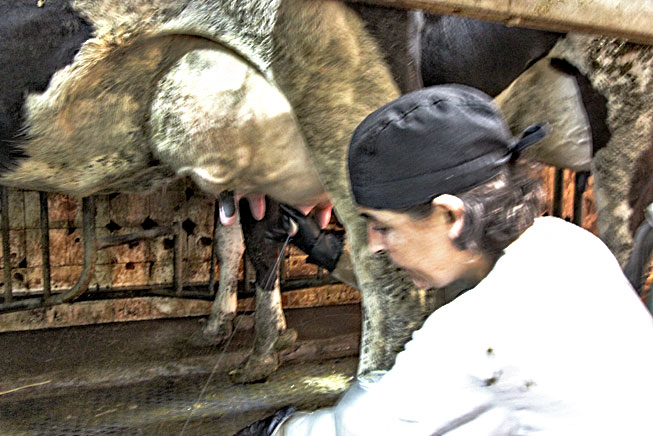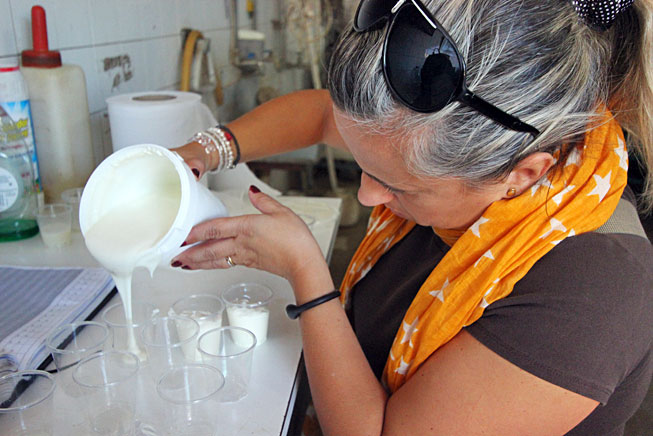Ana Serra never thought she would end up being a dairy farmer. Like many kids who grow up in the country, after finishing her education she left her family’s farm in rural Catalonia, Spain for a career in the city. In 1987, stressed out by the demands of business, she and her husband, Alfons Mir, returned to the farm, Granja la Selvatana, for some much needed rest and relaxation. This time, they stayed.
These days, Ana has swapped her business suits for a full-length vinyl apron and a baseball cap, worn backwards to hold back her unruly curls. At the crack of dawn each morning she rolls out of bed and climbs into the “pit,” a concrete slot between two raised platforms where her cows wait to be milked. On this particular morning I watched from above as she cajoled the cows with a series of whistles and “hey-heys.” Once they were in position, she turned to our small group and demonstrated how to milk a cow.
“Press, go down, leave it,” she explained, gripping her forefinger with her other hand and sliding it down to her fingertip. “Come, you can try if you like.”

I descended the dung-coated metal steps gingerly, taking care not to slip, and stood beneath one of the enormous black and white beasts. Anxious for the pressure of her swollen udder to be relieved, the cow mooed and shuffled back and forth. I reached up, grabbed a teat and firmly slid my hand downward. Miraculously, a steady stream flowed out; I was milking a cow! My elation was soon tempered when the cow’s tail slapped me, painting my mauve t-shirt brown with poop. Fortunately, automatic milking machines have long replaced the manual method. Once we’d all had a hand at milking, Ana cleaned the teats and udders of each cow before attaching vacuum-driven pumps. When the udders were drained, the machines stopped automatically and the cows scampered back to their feeding troughs.
The 80 Friesian cows at Granja la Selvatana, all descendants of the original 50 brought over from Denmark by Ana’s grandfather in 1970, range in age from 14 down to a calf that had been born just 12 hours earlier. We took turns feeding the baby with a huge bottle as Ana explained why her cows live so much longer than those on other dairy farms.
“They are supposed to pay the bills. They have to pay the electricity, the people who are taking care of them. Normal farms, they want milk, milk, milk and they give them a lot of food – weird foods that make more milk – and they put hormones in. This makes the cows die.”
Early on, Ana and Alfons decided against running an enterprise based on profit alone.
“What usually people do is that you milk and you put it in the tank, and…a truck gets all the milk…and you don’t see it any more. So, what happens? When you get up in the morning and you are very tired…you can do what you want because you don’t care. Nobody’s gonna see it because they are gonna mix it with everybody so you don’t have that much responsibility. What we decided to do is to create our own brand and start selling (organic yogurt). This is very cool because you are happy. In the morning, when I am tired I remember the face of the kids when I come to school to take the yogurt and they are all in the playground and they go ‘Wow! The yogurt, the yogurt!’ And you see those faces and you remember and you make things with more ‘elotion.'”
I chuckled when she said “elotion,” because her mispronunciation was so appropriate, the combination of emotion and love is clearly present in all that they do. And I’m pretty sure that the cows would agree. Not only are they fed on a healthy diet of 60% grass and 40% cereal with no added soy, they are also free to go out to the pasture once they have been milked. I overheard Ana whisper to our hosts that we should stick around until the cows were all milked, promising that we would see something “muy impresionante.” So we moseyed over to the office, where we were offered small sample cups of Biogust, without a doubt the richest, creamiest yogurt I had ever tasted. Two cups later I reluctantly followed the group back to the barn, casting a longing glance backward at the still half-full tub of yogurt.

Ana lined us up in a row on one side of the barn door. “Don’t be afraid,” she cautioned. I heard them before I saw them, thundering hooves headed our way. Seconds later, one black and white head emerged, followed by another and another, until the entire heard was galloping by, headed for the open pasture. I never knew cows could move so fast! Ana was right; it was very impressive.
As for Ana, she has never looked back. “It’s very cool to make food. For me, the most important things are teachers, doctors, and farmers. These are the three professions that have extra values for humans,” she says. Granja la Selvatana may have happy cows, but they also have happy owners, and it shows in every delicious mouthful.
My trip to Granja la Selvatana was hosted by Costa Brava Pirineu de Girona. However, the receipt and acceptance of complimentary items or services will never influence the content, topics, or posts in this blog. I write the truth, the whole truth, and nothing but the truth. If you are planning a trip to the Catalonia Region of Spain, you can visit Granja la Selvatana and learn about the production of Biogust organic Yogurt in person. For more information or to make reservations, contact the Girones Centre de Visitants (Gerona is the Catalan spelling of Girona) Avinguda de Franca, 221, Sarria de Ter, Girona 17840, Phone:972 011 669 (country code +34)

What a great adventure! The cow milking is an experience that I think everyone must try (although I have never ever tried it myself). A few weeks ago, I was hitchhiking through Romania and ended up staying with a guy in a little village who kept goats. I love goats cheese and delighted at the prospect of the fresh milk, I gulped down a big swig of it.. it was still warm.. and YUK! I don’t like goats milk apparently. Maybe like you, I should turn it into yoghurt…
Hi Jamie: You gave me my laugh for the day. Haven’t tried goat milk – warm, Yucch! – but love goat cheese. I’d say you’ve got the right idea!
Hi, the Pictures look so natural. milking a cow willbe a good experience.
“Teachers, doctors and farmers” – I love it. Sounds like Ana has got things pretty much worked out!! 🙂
That’s so cool! Although not the part about getting cow poo on your shirt. It’s really great to hear about wonderful people wanting to do things because they want to help and contribute to society, not purely make a profit.
Ana is a wonder, Ali, and the best part is that she’ll do tours for any visitors. Although I do suggest wearing old, old clothes 🙂
I remember milking a cow being much harder than I expected 🙂 Mmm that dairy produce must be so good!
Interesting, Natasha. Maybe I’ve just got the magic udder touch?
This post gives me happy elotions 🙂 Also – I’ve never milked a cow – I must add that to my to-do list!
From how I see it, I think milking cow is fun.. and easy? Just a matter of “press, go down, leave it”.. that seems pretty easy. 😀 But kidding aside, I do respect our farmers, not only because they handle our food, but they make it a point that they deliver the best for everyone.. healthy ones.
Me too, Rachel. And coming from the Midwest, I know farming is not an easy way to earn a living.
I had experience in milking a cow in Spain. I miss that when I watch the video taken at Granja la Selvatana. I’ve tasted the organic yogurt. I can say that it’s healthier and more delicious than the processed one.
Hi Jason: I’m missing that yogurt here in France – all the yogurt in the markets here are partially made with powdered milk and mostly by companies like Danon. Yucch! But on the other side of the coin, French cheese is awesome!
I live in Girona and I also attended TBEX, as you. I’m so grateful with you after read your words about my country. We are so proud about we do and how we do it, but I never know, if others will appreciate it. Thank you to transmite to you readers what land means to us
I can’t wait to read next posts
Isabel
Hi Isabel: Thank you so much for your comment. I don’t think we met at TBEX but I appreciate the fact that you are visiting my blog. I loved Girona so much I’m headed back there for a few weeks soon. Maybe we could meet then?
This is a sweet story – maybe I’m just a sucker for happy cows. It’s true though that when it comes to food, you really can taste the difference that a little “elotion” makes.
It must be the “elotion” Jessica because it was absolutely delicious!